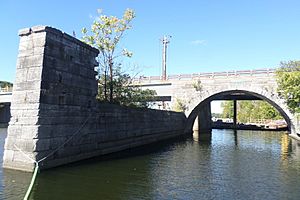Aqueduct, New York facts for kids

Aqueduct is a small community, also known as a hamlet, located in the Town of Niskayuna. This town is part of Schenectady County, New York, in the United States. The center of Aqueduct is found at the southern end of the New York State Route 146 bridge. This bridge, also called Balltown Road, crosses the Mohawk River. It connects Schenectady County to the south with Saratoga County to the north.
Aqueduct was once a very important place for travel and trade. Before the aqueduct was built, there was a bridge called Alexander's Bridge across the Mohawk River. In the early 1900s, a new steel highway bridge for Route 146 was built next to the aqueduct. A trolley line from Schenectady also ended here. This line also served Luna Park, an amusement park just across the river in Rexford. Aqueduct even had its own train station for the Troy & Schenectady Railroad, which ran from 1841 to 1932.
The Famous Water Bridge
The community of Aqueduct gets its name from a special kind of bridge called a navigable aqueduct. This aqueduct was not used to carry drinking water. Instead, it was a "water bridge" that allowed boats on the Erie Canal to cross over the Mohawk River. The mules that pulled the boats also crossed on this bridge. The Mohawk River flowed underneath the aqueduct. After crossing the river, the aqueduct continued west along what is now Aqueduct Street, leading into downtown Schenectady.
Building the Aqueduct
The first aqueduct was built in 1828. It was made of timber, which means it was built from large logs. Since cameras didn't exist back then, we don't have any pictures of this original wooden structure.
In 1842, the timber aqueduct was replaced with a new one made of stone and brick, known as masonry. This new aqueduct was very famous. Pictures of it were often used in advertisements for the Erie Canal. You could also find its image on postcards and calendars.
The Aqueduct's Legacy
Most of the masonry aqueduct was taken down in 1918. This happened when the New York State Barge Canal replaced the old Erie Canal. However, a small part of the aqueduct still remains today in Rexford. It stands as a reminder of the area's important history in transportation.



